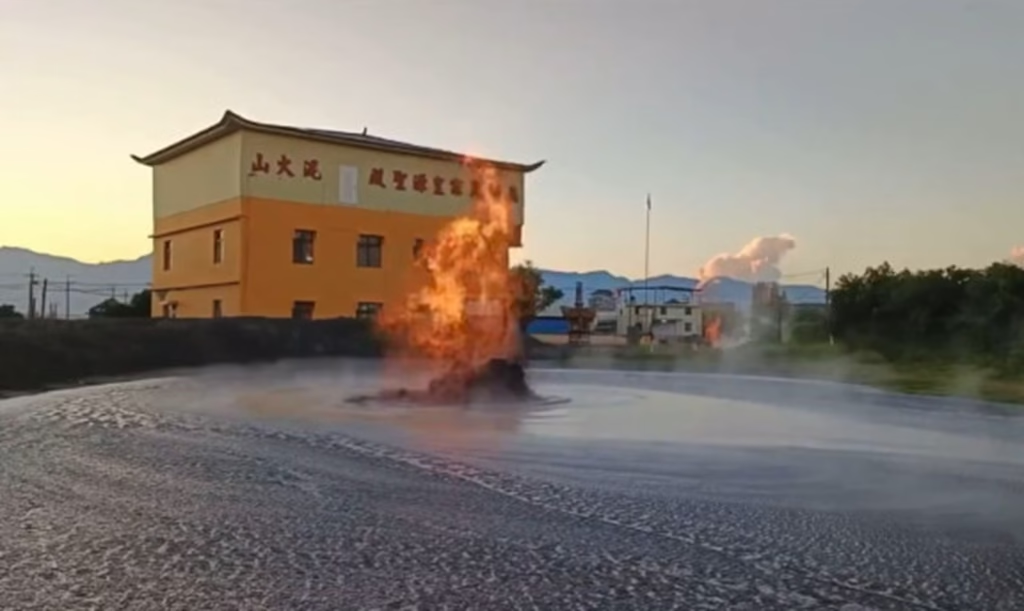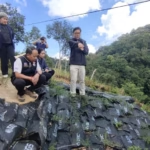TIAWAN – In the dark hours before dawn on Saturday, people in Wandan Township woke to a deep roar that shook windows and nerves. From what had long been a peaceful patch of farmland, the Wandan mud volcano, once known as a quirky sightseeing spot, burst into violent activity, blasting muddy water and gas more than 20 metres into the air.
Witnesses said the scene felt almost unreal. “It was like a dragon waking up,” said local farmer Lin Mei-hua, 58, who ran outside at 4:17 a.m. after her house began to rattle. “The ground trembled, then a huge jet of brown water shot upward, hissing and bubbling. The smell of gas was everywhere.”
By sunrise, emergency teams had sealed off an area of about 500 metres around the vent, which sits just off Provincial Highway 27. Firefighters wearing gas masks put out small fires started when methane in the air caught sparks from nearby machinery. Crews from the Taiwan Power Company cut the electricity in the zone as a safety step to prevent possible blasts.
Mud volcanoes are uncommon, with fewer than 1,100 known worldwide, and Wandan’s version is unusual even among these odd features. Instead of forming a steady, cone-shaped mound of thick, slow-flowing clay like those in Azerbaijan or Indonesia, the Wandan site behaves more like a very powerful geyser.
Standing at the edge of the closed zone, Dr Hsu Shih-wei, a geologist with the Central Geological Survey, outlined what makes it different. “Most mud volcanoes release cold, sticky mud little by little,” he said, pointing towards the active crater. “Here, a high-pressure aquifer sits trapped under hard shale. When that pressure breaks the seal, often along a fault, the system shoots out water, fine mud, and gas in short, strong bursts.”
Scientists describe this as a hybrid feature, known as a “mud geyser” or “salse”. Tests show the erupting fluid is about 70 percent water, 25 percent very fine clay, and 5 percent gas. The gas is mainly methane, with small amounts of carbon dioxide and hydrogen sulphide. This mixture produces the tall, water-rich jets that make Wandan different from mud volcanoes that behave more like thick, crawling flows.
Why the Wandan Mud Volcano Blows So Forcefully
The energy behind Wandan’s eruptions comes from Taiwan’s tectonic setting. The island lies where the Philippine Sea Plate pushes against the Eurasian Plate, so it is cut by many faults that act like pressure outlets. In Wandan, the Chishan Fault meets a layer of Pliocene-age mudstone that holds a great deal of groundwater. Over thousands of years, bacteria broke down buried organic matter in that mudstone, creating methane gas that dissolved in the pressurized water.
“When tectonic stress or a rush of new groundwater pushes the system past its limit, it gives way,” Dr Hsu explained. “Once the seal breaks, the pressure drops fast and the methane comes out of the water, like opening a bottle of champagne. That rapid expansion drives the eruption.”
Satellite images reviewed by National Central University show that the current activity was likely sparked by a small earthquake of magnitude 2.1 at 3:59 a.m. Minutes later, sensors in monitoring wells recorded pressure jumping from 8 bars to 47 bars, similar to the force inside a heavily shaken drinks can.
By around 10 a.m., the main vent had settled into a pattern of pulses every 40 to 50 seconds. Each burst lasted about 15 seconds and rose 15 to 18 metres high. A smaller crack about 30 metres away began to leak a constant flow of warm, coffee-coloured mud that crept across nearby pineapple fields and buried plants under about 30 centimetres of sludge.
Tests by the Pingtung County Environmental Protection Bureau found methane levels at the site reaching up to 1,200 ppm, which is above the 1,000 ppm level where ignition becomes a real risk. Officials evacuated 47 households within 300 metres of the vents. No injuries have been reported so far, although three farm workers sought treatment for eye irritation linked to hydrogen sulphide gas.
Local tourism facilities suffered obvious damage. The timber boardwalk that once brought visitors to the edge of the quiet crater now lies in broken pieces. Stalls selling “mud volcano eggs”, quail eggs cooked in the warm pools, stood empty with goods left behind as vendors fled.
Scientific Gains Amid the Turmoil
For scientists, the event offers a rare chance to gather high-quality data. A research group from Academia Sinica arrived with drones fitted with thermal cameras and gas sensors. “This is the strongest eruption here since 2005,” said volcanologist Dr Lin Yi-chun. “We are recording gas flow and particle sizes in real time, which helps improve models of how fluids move underground.”
Early measurements show the water temperature at about 38°C, similar to human body temperature, with a pH of 7.8, slightly on the alkaline side. When the fine mud dries, it becomes a smooth clay that local potters value, although the current activity makes any collection attempts too risky.
The Wandan mud volcano first appeared in 1977, after Typhoon Thelma triggered landslides that broke into the aquifer beneath. Since then, it has erupted 11 times. During a major burst in 1992, a mudflow about 50 metres long reached Highway 27. Each active phase usually lasts between three and seven days, then the vent returns to mild bubbling and gentle gas release.
Scientists suspect that climate change may be shifting the pattern. “Heavier rainfall means more water going into the ground in a short time, which raises pore pressure faster,” Dr Hsu said. “That could lead to more frequent or more powerful eruptions.”
The Central Geological Survey plans to set up permanent pressure gauges and webcams around the site to provide early alerts. For now, authorities advise residents to keep windows closed, avoid any open flames, and stay clear of the restricted area.
As evening settled over Wandan, the mud volcano kept firing its rhythmic jets, noisy and strangely mesmerising. Beneath Taiwan’s rice fields and betel nut groves, the ground showed that it still holds restless energy. For Wandan’s people, this mud volcano remains both a hazard and a local icon, a demanding neighbour that insists on attention whenever it decides to wake.













